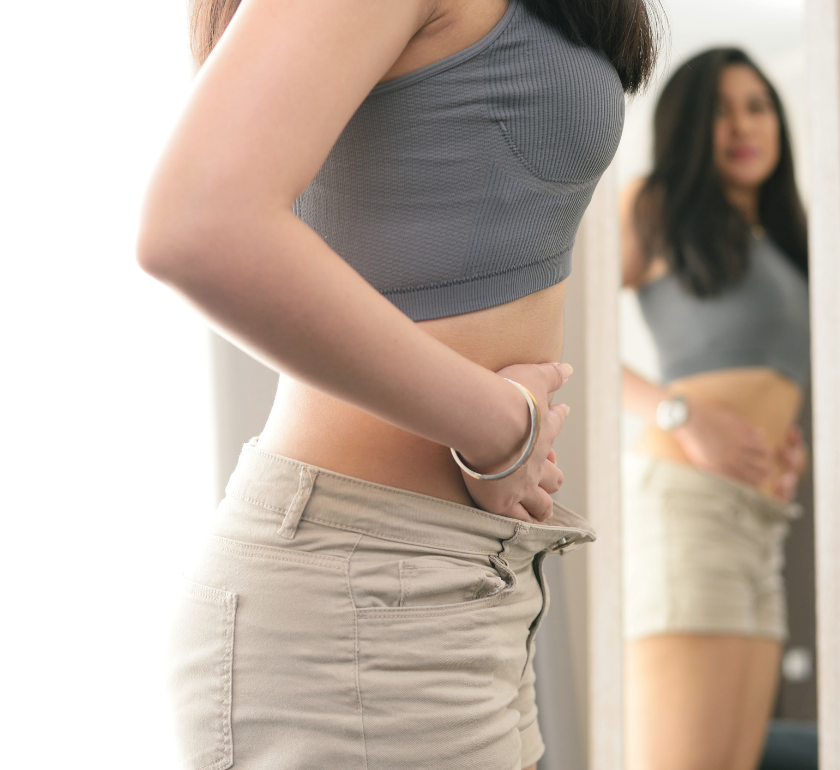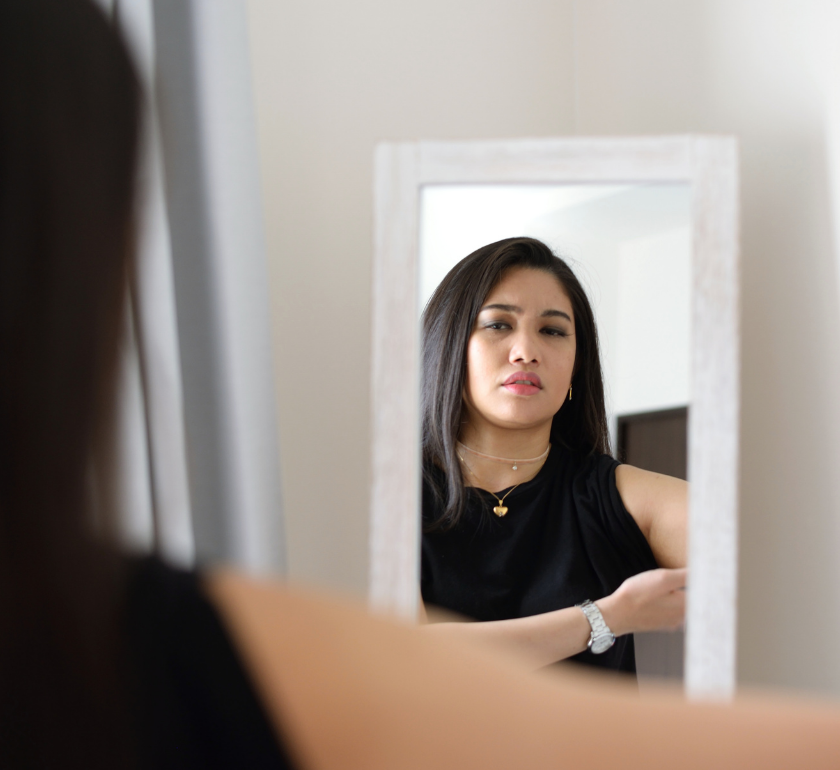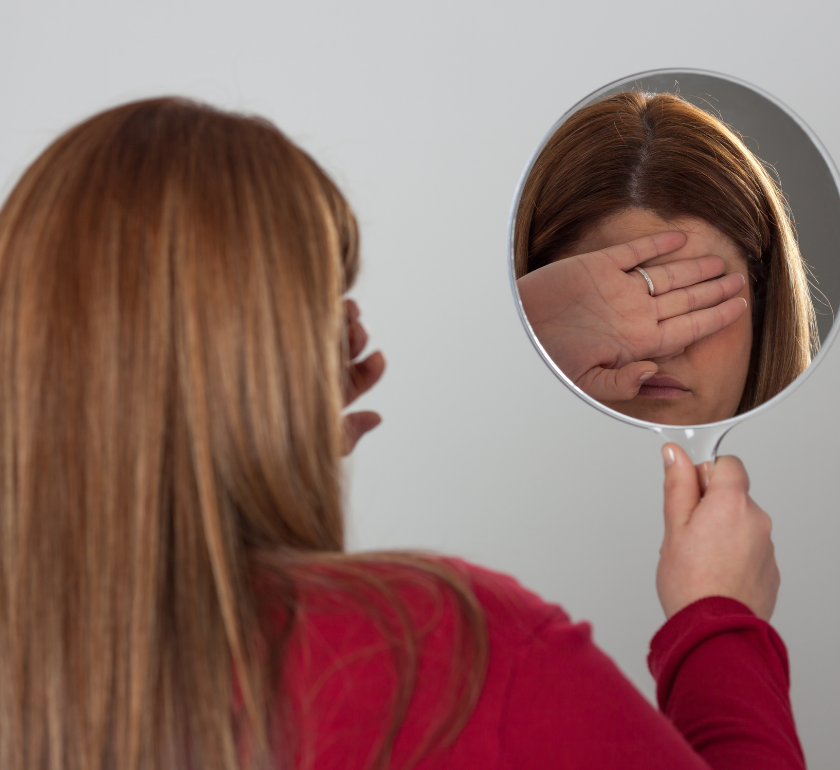Body dysmorphia and negative body image are prevalent issues in our society. These issues are triggered by society, culture, social groups, and perceptions about beauty. Yet, key differences such as internal and external influences increase these behaviors’ manifestation and negative thought patterns. Additionally, misidentifying these issues by considering them the same is problematic. In reality, they’re two separate and unique conditions.
Page Contents
Defining Body Dysmorphia And Negative Body Image
To properly understand why body dysmorphia and negative body image are different, you need a definition of each.
Body dysmorphia is a mental disorder in which you have a strong aversion to an imagined or minor flaw. It increases your desire to avoid social functions and obsess about how to “”fix”” said imperfection.
On the other hand, negative body image deals with a negative perception, thoughts, and feelings about your body’s appearance. You’re’ dissatisfied with how your body looks compared to others and want to change specific aspects of your body, such as breast size or weight.
These conditions create a toxic relationship with your body, complicate self-esteem, and lead to unhealthy consequences such as eating disorders, low self-esteem, and social anxiety. Additionally, symptom similarities, behavior, and complications make it difficult to tell them apart.
Similarities Body Dysmorphia And Negative Body Image Share
The symptoms of body dysmorphia and negative body image intersect, creating the illusion that they are the same. For instance, cultural and societal views on beauty are a common trigger for both.
Societal and Cultural Influences
We live in a society that has created unattainable beauty standards for men and women alike. Factors such as age, complexion, race, hair texture, height, and body type influence perceived beauty; additionally, society’s expectations of beauty and cultural influences play a role in body dysmorphia and negative body image behaviors.
For example, many racial groups idolize a particular body type representing their cultures’ ideal beauty standards. For instance, black American culture exhibiting a curvy hourglass figure with full hips is the perfect physique Black women should emulate. At the same time, Asian cultural beauty standards idolize tall, slim bodies with a fair, flawless complexion.
Furthermore, the rise of social media is another common trigger. The glorification of influencers, perfectly edited photos, and face blurring filters have contributed to an unhealthy view of beauty and body image.
Social Groups
Social groups significantly impact body dysmorphia and negative body image. For example, growing up in a household that praised thinness and disapproved of your weight contributes to your perception of your body. In this instance, it’s’ only natural that you develop a negative body image and obsess over your weight.
Peer groups you’re’ a member of also impact body dysmorphia and negative body image. If they are obsessed with their body, make negative fatphobic comments, and buy into the societal approach to beauty, they can begin to influence you to do the same.
For example, if they’re focused on restrictive dieting, over-exercising, or trying to look like a fitness model, you may also pick up on these habits.
Experiencing verbal abuse or bullying in which someone makes disparaging comments regarding your body and appearance alters your self-perception. Additionally, physical and sexual abuse can shift how you feel and see your body.
Toxic Self-Perception
Perhaps, the most significant similarity between body dysmorphia and negative body image is it erodes your self-perception contributing to a toxic body image. This unhealthy relationship manifests in various ways.
For instance, you may feel such displeasure with your appearance that you can’t’ go into public without make-up. Or, you’ll’ become addicted to cosmetic procedures to correct flaws and imperfections.
If you’re’ unhappy with your weight, you may develop a disordered relationship with food and follow restrictive diets and over-exercise to achieve the perfect figure. Perhaps you weigh yourself every day or take measurements of your body. Or, you alternate between picking yourself apart in the mirror or avoiding mirrors altogether.
Another common trait body dysmorphia and negative body image share are that they contribute to poor self-esteem. As a result, you’ll’ make disparaging comments about your body and are overly critical about your appearance.
Furthermore, it’s’ common to engage in negative self-talk in which you think hurtful things about yourself and your body. You’re’ constantly comparing your body to others either in your social circle, celebrities, or people on social media. And, you need constant reassurance from loved ones about how you look.
Sometimes these dysfunctional feelings and actions progress to avoiding social situations and self-isolation. You find that your insecurity about your body and appearance interferes with how you interact with others.
What Makes Body Dysmorphia And Negative Body Image Different
Upon first glance, the above similarities can make the body dysmorphia and negative body image appear the same. However, they’re not. One main difference is body dysmorphia is a mental disorder, whereas negative body image is negative feelings and thoughts regarding one’s appearance.
Another area where body dysmorphia and negative body image differ is the internal and external triggers. In regards to body dysmorphia, there are more internal drivers at play. As it pertains to body dysmorphia, the belief that you have a defect or deformity is internally driven by a personal need for perfection.
On the other hand, negative body image is externally driven by society, culture, and social aspects. These extrinsic factors are responsible for fueling your comparison to unrealistic beauty standards and alter your feelings, thoughts, and perception of your body and appearance. Additionally, these feelings can impact more than just body image and affect self-image.
The final factor that makes body dysmorphia and negative body image different is the singular fixation instead of general dissatisfaction.
When you have body dysmorphia, you fixate on one singular imperfection and go to great lengths to correct it. Indeed, you tend to view this imperfection as a deformity and seek out extreme corrections such as restrictive dieting, heavy make-up usage, cosmetic procedures, and plastic surgery.
Whereas when you have a negative body image, you take issue with your overall appearance. Instead of one specific feature, the focus is on improving everything. For example, obsessing over a celebrity’s perfect physique and attractiveness compels you to change your appearance. You create a goal to lose weight or have cosmetic procedures to achieve a similar look.
The Breakdown
Body dysmorphia and negative body image share similarities in that cultural, societal, and social groups influence how you perceive yourself compared to others. Thus, creating unrealistic and unattainable beliefs about what beauty truly is.
However, body dysmorphia is a mental disorder with internal triggers, and negative body image is a negative perception triggered by external factors.
The similarities and differences have severe and damaging complications. For example, eating disorders, disordered eating, social anxiety, increased risk of self-harm, decreased self-esteem, mood disorders, and relationship problems are typical.
The good news is that they’re treatable with therapy, support groups, working with a registered dietician to navigate any disordered eating issues, and proper education regarding social media and celebrity culture.
What Can You Do?
We live in a technologically advanced world where we’re’ constantly plugged in via social media and various entertainment outlets that reward you for aligning with socially acceptable beauty standards. Unfortunately, this is a significant problem regarding body dysmorphia and negative body image.
As a result, it’s easy for you to fall prey to doubt and dissatisfaction with your body and appearance. In turn, you may feel compelled to alter and change your appearance via dieting and weight loss or pursue extreme changes such as plastic surgery.
Knowing all this, is it possible for us to overcome the hurdles created by culture and society and have a healthy and positive relationship with our body and appearance?
Yes, we can. The answer lies in denying societal and cultural beauty standards to dictate how we view and see beauty. Instead, prioritize non-aesthetic traits to become the characteristics that celebrate the worth and value of each individual as opposed to idolizing a select few.
It’s time to stop pretending that beauty and perfection exist. Let’s be honest that most celebrities don’t look the way they do. Having access to make-up artists, hairstylists, fashion designers, and perfect lighting can make anyone look otherworldly. But, the reality is it’s a fake fantasy land created to make us feel inadequate.
And social media is no better with its endless smoke and mirrors. The face blurring filters, FaceTune, and the various mediums a person can alter their appearance. We have to realize that celebrity, entertainment, and social media photos make great art.
The artistry is aesthetically pleasing and makes for great photos and ad campaigns. But that’s it. It’s not worth comparing ourselves and feeling less. We’re enough just the way we are. Because celebrities, brands, and social media influencers need us more than we need them. Without us, they wouldn’t have a pedestal to perch on.
References
Mayo Clinic Body Dysmorphic Disorder Oct. 2019
Healthline What to Know About a Negative Body Image and How to Overcome It by Rebecca Joy Stanborough, MFA, medically reviewed by Marney A. White, Ph.D., MS Nov. 25, 2020
WebMD Body Dysmorphic Disorder medically reviewed by Smitha Bhandari, MD June 30,2020
Park Nicollet Melrose Center Teens, Social Media, and Body Image Heather R. Gallivan, PsyD, LP









